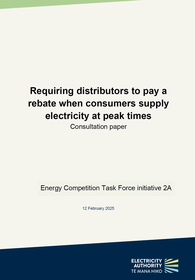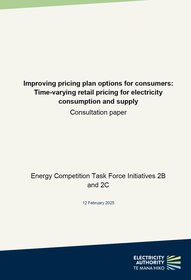New ways to empower electricity consumers
Consultation
Thanks to all those who provided feedback on this consultation. We have published submissions and cross-submissions below.
This consultation sought feedback on our proposal to change some of the electricity industry rules to give people on standard power plans (individuals and businesses) more control over their power use and costs.
The new rules would make sure:
- large retailers offer a pricing plan that gives consumers cheaper rates for off-peak electricity
- the price retailers pay to people who sell power to the network from solar systems reflects the true value of that power.
The new rules would benefit all New Zealanders over time, because less demand on the electricity system leads to lower lines costs, which we all pay through our power bills.
Overview for consumers
Consumers can read an overview of the proposals below or in our 'New ways to empower electricity consumers' guide.
Proposed new rule: All large power companies must offer their customers at least one time-of-use plan
Our proposed new rule would apply to the biggest retailers who sell power to 83 per cent of all households and businesses.
We surveyed retailers in October 2024 and found that:
- none of the six largest power companies currently offer a time-of-use plan to all customers
- some of these power companies do offer time-of-use plans to some customers, usually EV owners
- some power companies have said they plan on offering time-of-use plans in the future.
What is a time-of-use plan?
Power prices are most expensive when demand is high (peak), and cheapest when demand is low (off-peak), but most people pay a fixed rate for power.
Time-of-use pricing plans offer cheaper power at off-peak times, and more expensive power at peak times. This means you can save money by using more power when it’s cheap, and less when it’s more expensive.
The ‘peak’ times are typically on weekday mornings when everyone’s getting ready for the day (7–10am) and evenings when everyone’s cooking dinner and running heaters (5–9pm). Off-peak times are usually overnight, in the middle of the day or on weekends.
Power is cheaper off-peak because it’s easier and cheaper to generate enough power to meet the lower demand at these times.
How much could I save with a time-of-use power plan?
If you’re careful about when you use the most power, you can reduce your power bills by about 20 per cent. But if you don’t change your habits, you could end up paying more than you would on a fixed-rate plan.
Are time-of-use plans good for everyone?
If you use a lot of electricity for things like for an electric vehicle and you can charge it during off-peak hours – you could save a lot.
If you can’t change your electricity habits, a time-of-use plan is unlikely to save you money.
Proposed new rule: All large power companies must offer at least one ‘time-varying’ rate for power they buy from people with solar and battery systems
Our proposed new rule would apply to all large retailers who sell power to 83 per cent of all households and businesses.
What’s a ‘time-varying buy-back rate’?
Power companies already pay people when they supply power to the network through their rooftop solar or battery systems. Most power companies offer a fixed ‘buy-back’ rate, no matter how valuable (or not) the power is when it’s supplied. ‘Time-varying buy-back' rates ensure the amount paid reflects the value of the power when it’s supplied. Only a few smaller companies currently offer a time-varying buy-back rate.
Our proposal would more fairly reward consumers who have rooftop solar and batteries and encourage more people to make that investment. It would also reduce power bills for everyone over time as it lowers the costs of providing power at peak times.
How we propose power companies promote these plans
Under our proposed rule changes, power companies would have to promote their plans to their customers in three ways:
- show time-of-use and buy-back plans on their website
- include the plans on our consumer switching website (currently Powerswitch)
- proactively offer time-of-use and buy-back plans to the customers likely to benefit.
Proposed new rule: Lines companies must pay a rebate when people supply power when it’s needed
People with rooftop solar and battery systems can supply power to the local electricity network. This can reduce demand on the network, which lowers the lines costs we all pay for through our power bills. This proposed new rule may encourage more people to invest in rooftop solar and batteries.
The rebate would:
- only apply when people supply power at peak times and where it saves lines companies money
- go to power companies who pass savings onto those who supplied the power (through the proposed time-varying buy back rates – see above)
I have solar panels on my house but no battery. Would I get a rebate?
The rebate is for power supplied at peak times (mornings and evenings), so if you don’t have batteries, it’s unlikely you will be able to supply power at peak times. This is because batteries store solar energy from the middle of the day so you can supply it at peak times.
How much is the rebate?
The rebate is not yet decided, but our proposed new rule would make lines companies and retailers pay a rate that reflects the value of the power you sell from your solar system. We would like your feedback on the three options for deciding how lines companies decide the rebate.
Will this push up prices for people without rooftop solar?
We expect any short-term price rise would be negligible (1 cent/month), but everyone would benefit from cheaper power bills over the long term.
We’re considering three options for how lines companies set the rebate
- Lines companies follow principles when deciding the rebate. This option has less strict rules and would enable lines companies to design the rebates to match the value the power from solar brings to the local network, considering local conditions.
- All lines companies use one formula. This option gives lines companies clearer rules to follow but does not allow them to match their rebate to the value the power from solar brings to the local network.
- Each lines company links the rebate to the rates they charge for power use. This option is easier to implement but does not enable them to match their rebate to the value the power from solar brings to the local network. This is because power use rates aren't always an accurate measure of the cost of power at particular times.
Each local power network has different levels of demand (total power used in an area) and capacity (how much ‘space’ there is on the network) – and these both change with time.
We think the rules should be flexible enough so the rebate reflects the local levels of demand and capacity – and be able to change.
This would mean only people who supply power when it’s needed would receive the rebate.
Consultation papers
Related consultation
As part of this consultation package, we also welcome feedback on the Authority’s Distributed generation pricing principles issues paper.
This paper considers an issue relating to existing regulations for distribution pricing for distributed generation, including solar and wind farms directly connected to the network.
We’ve included the issues paper as part of this consultation package so those with an interest in distributed generation can consider both sets of issues relating to distribution pricing at the same time.

